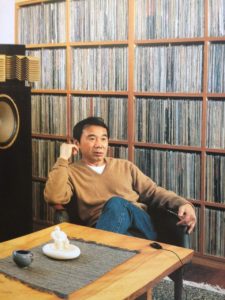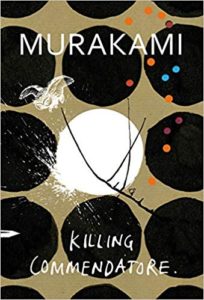Haruki Murakami’s “Killing Commendatore”
Haruki Murakami’s latest novel Killing Commendatore ( translated from the Japanese by Philip Gabriel and Ted Gossen) is about a nameless male narrator who is a portrait painter. He is excellent at his work and in great demand. His methodology is unique as he never works with a live model but before commencing work has long conversations with the subject, sometimes spread over many hours:
It was critical to feel a sense of closeness, even just a little, toward the client. That’s why during our initial one-hour meeting I tried so hard to discover, as much as I could, some aspects of the client that I could respond to. Naturally, this was easier with some people than with others. There were some I’d never want to have a personal relationship with. But as a visitor who was with them for only a short time, in a set place, it wasn’t that hard to fine one or two appealing qualities. Look deep enough into any person and you will find something shining within. My job was to uncover this and, if the surface became foggy (which was more often the case), polish it with a cloth to make it shine again. Otherwise the darker side would naturally reveal itself in the portrait. ( p. 14-15)
One day the artist retires to the mountains while his marriage crumbles. He retreats to the home of a famous Japanese artist Tomohiko Amada which is no longer occupied as Amada San has had to be admitted to an old people’s home by his son. It is the son Masahiko, an ex-classmate of the portrait artist, who sublets his father’s home. The portrait artist refuses to accept any more commissions even though his agent insists he should not vanish. All is well until an offer arrives that he cannot refuse. It is a commissioned project with one caveat. The portrait has to be made with a live model. And thus begins a professional relationship which morphs into familiar acquaintance between a neighbour and super-rich businessman Menshiki and the artist. An acquaintanceship that extends itself to looking out for each other while exploring the mysterious ringing bell in the garden of Tomohiko Amada. At this point a bizarre, fantastical, parallel dimension is added to the tale, much like going down a rabbit hole into another world. It involves the sudden appearance of a two-foot figure, the Commendatore, as seen in the painting. He insists he is an Idea who appears to a selective few humans but the fact the Commendatore exists and converses with the portrait painter adds a peculiar dimension to the story. Ulitmately this fantastical exploration is a mere artistic digression that doesn’t really add much to the plot except for offering a hint of magic realism.
Killing Commendatore the title is borrowed from the Tomohiko Amada painting discovered by the portrait artist in the attic. It is a very violent painting showing the killing of the commendatore from the famous scene in Mozart’s opera Don Giovanni. It is probably a turning point in Tomohiko Amada’s own career as an artist when he seemingly veered sharply from the European art tradition that he had learned in Vienna to that of a very classical form of Japanese painting. It is a painting with a scene from the Asuka period, set over a thousand years ago. But the violent manner in which the killing of the commendatore is depicted by Tomohiko Amada is interpreted by the portrait painter as being a painting that Amada San painted for himself alone. It probably hearks back to the time he spent in Europe, at the time of the growing power of the Nazis and in which the young Tomohiko Amada had got embroiled as well. It is probably why that this painting wrapped in brown paper is lying in the attic since Tomohiko Amada was known for getting rid of his paintings as soon as he had done painting them. This one he kept. Even his son did not know of its existence.
In typical Murakami style there are the male characters playing out their lives, sometimes very mundane existences. The almost Gatsby-like, very white haired, Menshiki who is very suave, wealthy, well dressed is very masculine at the end of day who always gets what he wants. ( Murakami translated The Great Gatsby into Japanese.) True he pays handsomely for all that he desires. But it is ultimately very masculine to not  expect a no. The portrait artist too falls under Menshiki’s spell even though he knows he is going to be paid very well for the commissioned portrait. The conversation is lack lustre. The women in the novel whether the ex-wife, the various mistresses, the young 13 year old daughter of Menshiki born of an affair he had a long time ago are reduced to sex objects. It is absolutely bizarre that the pre-pubescent girl is so obsessed by her breasts and her first frank conversation with the artist is about her chest size. It is ugly.
expect a no. The portrait artist too falls under Menshiki’s spell even though he knows he is going to be paid very well for the commissioned portrait. The conversation is lack lustre. The women in the novel whether the ex-wife, the various mistresses, the young 13 year old daughter of Menshiki born of an affair he had a long time ago are reduced to sex objects. It is absolutely bizarre that the pre-pubescent girl is so obsessed by her breasts and her first frank conversation with the artist is about her chest size. It is ugly.
And yet in Killing Commendatore there is something very different, very compelling to read, despite the unfortunate portrayal of women. It is as if in this 70th year he wishes to reflect upon his craft and seems to bring together his two loves — the art of writing and his love for music. In many ways, the conversations in the novel revolving around music, or the artist putting LPs on the turntable while working, listening to opera, Strauss, Schubert, Verdi, while also being able to converse knowledgeably about Bruce Springsteen and jazz, are not out of character for Murakami who is known for his love for music. This novel’s dramatic storytelling is much in a similar vein to that of operatic dramas that are definitely overdone. Not many will appreciate this novel for it tends to meander a fair bit but on the other hand it is an act of patient endurance upon the part of the reader to fully admire Murakami’s writing.
I am glad I read the book and I am not even a Murakami fan.
As always the amazing Chipp Kidd has designed the cover for this novel too. 25 years he has been designing the covers for Murakami’s novels. First time in 25 years Murakami asked Kidd to revise his draft drawing. Here is the story published on Vulture.
The book had a global release on 9 Oct 2018, the same day as Frankfurt Book Fair opened. Great timing!
9 Oct 2018
To buy on Amazon India

